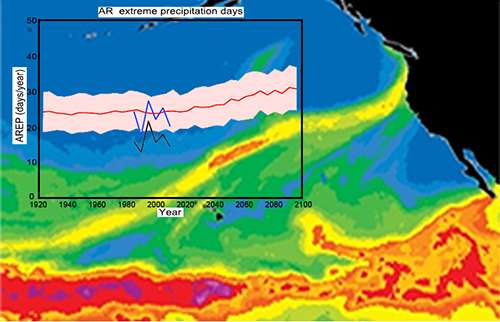More frequent extreme precipitation ahead for western North America

It may sound like a routine forecast, but it's not. Results from a careful modeling study conducted by researchers at Pacific Northwest National Laboratory found that Western North America and Canada can expect a 28 percent increase in the number of extreme precipitation days, thanks to global climate warming. In addition, the wintertime storm systems that often carry those extreme rainy days will hit the coast 35 percent more often in the future. The primary mechanism for these numbers is atmospheric rivers, narrow bands of tropical moisture streaming each winter season toward the US West Coast.
The response to warming they found is well beyond what is expected just in the natural climate variability.
"We found that the projected increases in atmospheric rivers and extreme precipitation frequencies are significant compared to the inherent uncertainty that exists in climate change projections," said Dr. Samson Hagos, lead author of this investigation and an atmospheric scientist at PNNL.
Some call it the Pineapple Express; scientists call it atmospheric rivers. Each name points out key characteristics of the storm: its origin-the tropics-and the large amount of moisture aimed with tenacity at the coast. When the strongest rivers make landfall, they can also make the evening news with flood and mudslide warnings in vulnerable communities.
Atmospheric rivers (ARs) are important for the water cycle because they are responsible for about 90 percent of global (north-south) water vapor transported from the tropics poleward. The Western states and Canada count on them for roughly 30 to 40 percent of their annual rainfall. ARs are found all over the world, though most dissipate in the ocean. But when they make landfall, they can disrupt daily living, and in some cases cause catastrophic damage affecting lives and property. The researchers in this study recognize that it's important to understand how ARs may respond to global warming. More certain information means western communities have a chance to prepare for and mitigate climate change.
Researchers at PNNL modeled the past and present to foresee a likely future activity of Pacific Ocean ARs. They ran the model under a "business-as-usual" scenario, which is what climate might look like if nothing is done to curb global warming. This scenario assumes a global mean temperature increase of 3.7 degrees Centigrade. When the added warmth is absorbed in the ocean, it is more likely to increase atmospheric water vapor, feeding atmospheric rivers.
The team analyzed a 29-member ensemble spanning 180 years of historical and future simulations from the Community Earth System Model Large Ensemble project. In detecting ARs from the simulations, they accounted for the model's wide range of answers for the subtropical jet position and extreme precipitation dependence on moisture supply. And they factored in the model's natural variability. When they calculated the model's projected responses to global warming and compared results against those that included the effects of model bias and model ensemble spread (caused by internal variability), they were able to assess the robustness of the large projected changes in extreme precipitation frequency.
The results also revealed regional differences in AR landfalls, specifically in the Northeast Pacific. Researchers assume the regional difference is from a poleward shift of jet stream (moving further north) and storm tracks projected in warmer climates.
Researchers will focus refined resolution modeling in regional areas over Western North America in hopes of examining the interactions of atmospheric rivers with complex terrain (i.e., mountains, coastal edges) that can affect the extreme precipitation associated with ARs.
More information: Samson M. Hagos et al. A projection of changes in landfalling atmospheric river frequency and extreme precipitation over western North America from the Large Ensemble CESM simulations, Geophysical Research Letters (2016). DOI: 10.1002/2015GL067392
Journal information: Geophysical Research Letters
Provided by Pacific Northwest National Laboratory


















